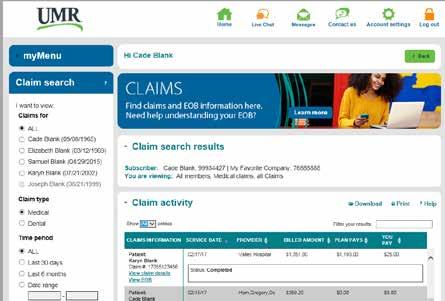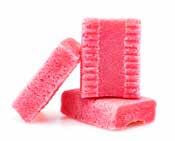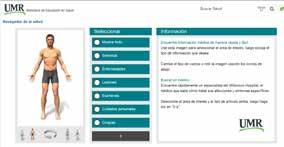












“Healthy You” magazine is published as an educational resource for UMR members and provides information about tools and resources available from UMR as a part of our member online services.
Available features and benefits are dependent on the products and features included in the plan design. Not all members will have access to all features shown.

Copyright ©2023 United HealthCare Services, Inc. Reproduction in whole or part is not permitted without permission in writing from UMR. All information and links were accurate and functional at the time of publication. However, because this electronic publication contains links to third-party sites, information can change and become unavailable.
While using this electronic publication, you may click on a link to other websites. We provide links to other websites that may contain information that may be useful or interesting to you. We do not endorse, and are not responsible for, the content and accuracy of linked websites operated by third parties or for any of your dealings with such third parties. You are solely responsible for your dealings with such third parties and we encourage you to read the terms of use and privacy policies on such third-party websites.
How to get moving on those cold winter mornings.
Choosing to be a blood donor could save a life – and improve yours.
12 Heart-healthy Valentine’s Day activities

Make your heart the center of your festivities.
Drinking tea can improve your well-being – and warm you up.
16 Is laughter really the best medicine?
Scientists say a good laugh has physical and mental benefits.
18 Keep your asthma under control
Learn how to manage your asthma symptoms when it’s cold and dry.
Try our tips for flying in good health and comfort.
We partnered with the National Kidney Foundation to share important facts about kidney health.
Discover the pros and pitfalls of this popular approach to building healthy habits.
UMR ON THE GO APP 4 TRACK YOUR CLAIMS 5 FIND A PROVIDER 21 SIMPLE RECIPE 30 WHERE TO GET CARE 31
THINGS TO DO ON UMR.COM 33 DON’T SKIP THE SHADES/ MONTHLY OBSERVANCES 34 EN ESPA Ñ OL 3 5
Register on umr.com to take advantage of all our online resources for members.
Welcome to a smarter, simpler, faster way to manage your health care benefits, right from the palm of your hand.
The UMR app has a smart fresh look, simple navigation, and faster access to your health care benefits information. View your plan details on demand - anytime, anywhere. With a single tap, you can:
• Access your digital ID card

• Look up in-network health care providers
• Keep up to date with information about your health account balances
• See how much you’ve paid toward your deductible

• Find out if there’s a co-pay for your upcoming appointment
• View your recent medical and dental claims
• Chat, call or message UMR’s member support team

Check out this FREE resource. Log into your member account on umr.com

Check in at your convenience to see if a claim has been processed and what you might owe. To get more details on a specific claim, click View claim details or View EOB. And, take advantage of the Action needed prompt to know when you need to follow up on a specific claim.

When the bedroom is chilly and your blankets are cozy, it can be tempting to hit snooze and stay under the covers. But when that groggy feeling carries over into your morning routine, it can set the wrong tone for your day.

Here are some tips to help you make the most of a cold, gray day – from the get-go.
A little caffeine in the morning can help you feel more awake and alert.

Drink a glass of water.
Sleeping dehydrates you, especially when the heat is running. A glass of cold or room-temperature water can increase your energy level and boost your metabolism.

Stretch.
A few simple stretches can help relieve tension or pain from sleep and increase blood flow to your muscles.

A short walk, a 10-minute yoga routine or even unloading the dishwasher will pump blood to your muscles and help you become more alert and focused.

Your body's circadian clock responds to light as a signal to be awake. Try a sunrise alarm clock, which combines a digital alarm with an artificial light source designed to mimic natural morning light.
You’ll be more likely to get started and stay on track if you take a few minutes to think through your priorities for the day.

Wash your face and moisturize.
A splash of warm or cold water on your face can feel invigorating and help wake up tired eyes. Be sure to use a moisturizer with sunscreen afterward.

Eat breakfast.
Choose something that will warm you up, energize you and help you feel full. Oatmeal with fruit or nut butter is a perfect choice.

In January 2022, the Red Cross announced that it’s experiencing shortages of blood storage and donations on a scale not seen in a decade.
Whether it’s for people injured in accidents, undergoing cancer treatments, battling blood diseases or a number of other reasons, these shortages are causing delays in critical blood transfusions that could mean the difference in life or death.
A healthy adult can donate a pint of blood with no negative side effects.
After a blood donation, your body will replace any lost fluids within 48 hours and replenish the blood lost within four to eight weeks.
When donating blood, there is no risk of contracting blood-borne infections or diseases due to the sterilization procedures in place.
According to the American Red Cross, someone in the U.S. is in need of a blood transfusion every two seconds.
Here’s what you can expect:
You’ll fill out some paperwork, show an ID and read some required information.
Either online or in a private interview, you’ll be asked some questions and receive a general well-being health check.
The actual donation only takes about 10 minutes. You’ll be seated in a comfortable chair, and the attendant will draw a pint of blood from your arm.
You’ll be offered a snack and a drink and will need to stay put for about 15 minutes. This is to help prevent or address any dizziness or fatigue you may feel.
For whole blood donation, the Red Cross sets forth these requirements:
Donation frequency: Every 56 days, up to 6 times a year*
You must be in good health and feeling well**
You must be at least 17 years old in most states (some states allow 16-year-olds to donate with parental consent)
You must weigh at least 110 pounds
* According to redcrossblood.org: The number of allowable donations per year may be lower due to red cell and plasma loss limit guidelines. Final eligibility will be determined by the American Red Cross at the time of donation.
** According to redcrossblood.org: Healthy means that you feel well and can perform normal activities. If you have a chronic condition such as diabetes, healthy also means that you are being treated and the condition is under control. If you are not feeling well on the day of your donation, please reschedule.

Your entire experience generally takes about an hour.
Aside from saving lives, donating blood can have positive impacts on a healthy adult:

Comes with a free blood analysis
That’s because the iron stores in your body remain at a healthy level when donating.
A lower iron store level in our bodies is connected to a lower risk of developing cancer, hypertension, obesity and insulin resistance, among other diseases.
Believe it or not, each time you donate a pint of blood, your body can burn up to 650 calories.
Keep in mind that donating blood should never be a way to lose weight!
Doing good for others has a positive effect on your mental health.

Another benefit of lowering the iron stores in your body is that your risk of acute myocardial infarction (or heart attack) is reduced.
After donating, your body will naturally replenish the blood removed.
Within about four to 12 weeks, you will have a fresh supply of blood pumping through your veins. This can help your body stay healthy and work more efficiently and productively.

Whole blood is the blood that flows through your veins. It contains white cells, red cells and platelets, all suspended in plasma. This is the standard type of donation in a blood drive.
Very similar to whole blood donation, except a machine is used that collects two units of red blood cells at once while returning the plasma and platelets back to your body.
Platelets are cells in your blood that allow clotting and stop bleeding. They are essential for people fighting diseases, especially cancer, because the disease itself and the side effects of treatment often deplete those patients’ blood of platelets.
AB is not a very common blood type – only about 4% of the population has it. The plasma from AB-type blood can be given to patients of any blood type. This plasma is used to treat burn, trauma and cancer patients.






















Whether you’re planning for romance or hanging out with a pal, make your heart the center of your Valentine’s Day festivities.











Take a brisk walk around your neighborhood or explore a new part of the city.
Pick a new hearthealthy recipe to prepare together.
Go ice-skating or roller-skating.
Volunteer for an activity that gets you moving, like a neighborhood clean-up.
Share some dark chocolate.
Commit to quit together if you both smoke or use nicotine.
Go dancing, take a dance class or have an at-home dance party.
Approximately 75-80% of tea consumed in America is iced.
While 64% of American adults drink coffee daily, about 48% drink tea every day. Both drinks have many health properties, but tea doesn’t always get as much attention in our coffee-centric society.


Although most people think of coffee as the ultimate American beverage, tea gives java a run for its money.


As with coffee, sweeteners and other additives can enhance the flavor of tea.
Experiment with combinations to find the taste you like best. Or try one of the many flavored teas available at the grocery store or online.
These ingredients go well with tea:
• Sugar or sugar substitutes
• Honey
• Lemon
• Cinnamon
• Milk or milk alternatives
• Ginger
• Mint or peppermint
• Fruit or fruit juice
• Chai powder
• Vanilla extract
• Lavender
• Maple syrup
Tea contains no sodium, fat, carbonation or sugar, and is virtually calorie-free. Both caffeinated and herbal teas contain natural antioxidants that may help reduce the risk of certain chronic diseases. These antioxidants can help neutralize free radicals, which scientists believe, over time, damage elements in the body and contribute to chronic disease.
In a U.K. study of 498,043 men and women between ages 40 and 69 led by researchers at NCI, part of the National Institutes of Health, researchers found that people who consumed two or more cups of tea per day had a 9-13% lower risk of death from any cause than people who didn’t drink tea.
Higher tea consumption was also associated with a lower risk of death from cardiovascular disease, ischemic heart disease and stroke.
Recent research suggests that tea and the antioxidant flavonoids found in tea may play important roles in various areas of health including heart health, certain cancers, neurological decline, factors related to diabetes, bone health and immune function.
While one 8-ounce cup of coffee contains about 95 milligrams of caffeine, most tea contains between
Decaffeinated black, green and oolong teas contain very small amounts of caffeine – about 2 mg. Many herbal
The U.S. Food and Drug Administration considers up to 400 mg a safe amount of caffeine for healthy adults to consume daily, but many people feel better when they limit their caffeine intake – particularly later in the day – as it can contribute to problems such as anxiety, insomnia, headaches and frequent urination.
There are many varieties of tea to choose from, which differ widely in flavor. According to the Tea Association of the U.S.A., black, green, oolong, dark and white teas all come from the same plant. The differences result from the various degrees of processing and the level of oxidization, which impacts their flavor. If you’ve only ever tasted tea made with highly processed plain black tea bags, you may want to experiment with other varieties.
Is highly oxidized, resulting in a dark reddish-gold hue and a hearty, slightly astringent flavor. About 84% of all tea consumed in the U.S. is black.
Taste differs from cup to cup, but it’s often described as grassy, flowery, earthy, nutty or bittersweet.
Has the combined characteristics of green tea and black tea. It can taste fresh and bright as well as woody and roasted (similar to black tea).
Has a light, delicate quality because it’s so minimally processed. Though the flavor can vary, it’s often described as “refreshing.”
Doesn’t actually contain any tea at all. It’s made from “tisanes,” which are blends or infusions of dried fruits, flowers, spices or herbs that give it a wide variety of flavors. The most popular types are chamomile, peppermint, ginger and lavender. Tisanes have been shown to offer medicinal effects.
Warm up with this slightly sweet, milky and aromatic hot tea drink this winter. It features Earl Grey, a black tea whose prime flavoring is bergamot, which gives it a mild citrusy flavor.

Earl Grey tea bag Milk (cow’s, coconut, almond or oat) Vanilla Honey Dried lavender (food-grade)
Bring 2/3 cup water to a boil and remove from heat. Add 1 Earl Grey tea bag and 1/2 teaspoon dried lavender to water. Cover and steep 5 minutes. In a separate mug, add 1/4 teaspoon vanilla and ¼ teaspoon honey. Strain the tea and lavender water into the mug and stir. Heat 2/3 cup milk and pour into the mug. (You can also froth the milk and spoon the froth on top.) Sprinkle with more dried lavender (optional).
After years of study, scientists concluded that a good laugh has great benefits to your body.
Stop ... you're cracking me up!
Did you hear the one about ...
Whatever makes you laugh can be good therapy, both mentally and physically.
You’ve probably heard of cortisol. It’s known as the “stress hormone” because your body releases it when you’re stressed. Cortisol is good in balance because it manages blood sugar levels, reduces inflammation, controls metabolism and triggers fight or flight responses at critical times. But too much cortisol results in a feeling of stress.
When you laugh, your oxygen intake increases, and that stimulates body circulation, which in turn decreases cortisol levels.
Endorphins are a type of hormone that increases our tolerance of pain when released in the body. When you have a good laugh, endorphins are released at a high rate – thus your pain tolerance is improved.
• Hanging out with your "funnier" friends
• Binge watching a good comedy series
• Reading a new book of jokes
• Going out to a comedy club
• Watching funny videos of people and animals doing silly things
• Sharing other things that tickle your funny bone
True laughter increases the amount of oxygen in your blood and picks up your heart rate, as well as stimulates your lungs and muscles. All of this is very beneficial for your heart.
When you laugh, your circulation is stimulated, which relaxes your muscles. The stress that causes your muscles to tense is lowered when you chuckle.
In fact, a good laugh can relieve muscles of extra stress for up to 45 minutes.
When you see or hear something funny enough to make you laugh, it lightens your mood. This can really help when you’re facing a challenging situation. Laughing also helps calm chronic depression and anxiety.

Winter brings many joys, from cozy sweaters to hot cocoa to holiday festivities. But if you suffer from asthma, the colder months can also bring added struggles. As temperatures drop and the air becomes dry, it can make breathing more difficult. Also, your lungs become drier and inflamed due to breathing in cold air. But there are a few simple ways to manage your asthma symptoms and still enjoy the winter season.

It can be difficult to find a happy

Increases your exposure to pollutants and allergens that build up in your home over time, causing poor indoor air quality.
Increases your exposure to air pollution, pollen and mold. Also, exercising in colder weather can cause your airways to become restricted, making it harder for you to breathe.


Symptoms you can experience include:
Coughing
Shortness of breath
Tightness of chest
Wheezing
Read the How to keep asthma under control article in the Spring 2020 edition.
When it comes to asthma, being prepared is crucial. That’s why it’s a good idea to have an action plan in place. This plan should include warning signs, as well as medication and dosage to be used during an asthma attack.
Important things to have in your asthma action plan are: 1. Known triggers –Pets, cold weather, infection, exercising, being upset, etc. 2. Medication information
Emergency contacts
A written plan –Share with family members, friends, teachers and health care providers so you or your loved ones have the support you need to manage your asthma.


Poor indoor air quality can lead to a range of health problems, including asthma attacks. One of the easiest ways to improve your indoor air quality is by replacing your air filters every 1–3 months. By replacing your air filters more frequently, you can reduce the amount of dust, pollen and other airborne contaminants in your home. Another option is to invest in an air purifier. These work to remove a wide range of particles, including mold spores, pet dander and cigarette smoke. It’s also helpful to avoid using strong cleaning products. Opt for natural or organic cleaning products and make sure to use them in well-ventilated areas.
Staying warm when you’re outside is another way to keep your respiratory health in check. When you breathe in cold air, it can have a negative effect on your lungs and airways, causing asthma attacks and other respiratory issues. One way to protect your lungs from the cold weather is by using a scarf to cover your nose and mouth when outdoors. This can help protect your lungs from harsh, cold air, which can put unnecessary strain on your respiratory system. It’s also helpful to breathe in through your nose instead of your mouth, as this warms and filters the air before it reaches your lungs.
Getting the flu shot can be more than just a preventive measure – it can also protect your respiratory health and reduce the risk of infections. During the colder seasons, you may already have difficulty breathing, and getting the flu will only makes those symptoms worse. It can also lead to pneumonia and acute respiratory disease.
Having asthma can be unpredictable, and you never know when you might need your rescue inhaler. While asthma medications can provide some relief, they work best when used early on during an attack. It’s best to always keep your inhaler on you.
Be sure to check expiration dates regularly and take your asthma medications as prescribed.


Though winter can be a challenge, with a little extra care, you and your family can enjoy all the joys of winter without asthma holding you back.
Luckily, there are a few things you can do to reduce the risk of these symptoms and better manage your asthma whether you’re inside or outside.
Finding a doctor or hospital on umr.com
Make the most of your health care dollars when you use in-network doctors, hospitals, pharmacies, labs and other providers.
Log in to umr.com
Once logged in, click on Find a provider
Search for a medical provider from your network listing
Call us with any questions
Find the toll-free phone number for UMR member services on your health plan ID card.

Domestic leisure air travel in the U.S. has bounced back to pre-pandemic levels. And American travelers with the necessary means intend to take an average of 3.8 international vacations within the next 12 months, up 72% from 2019*. That means you should start thinking about booking flights for spring break and summer vacation now.
Even if COVID-19 is less of a threat when flying now, it’s still important to take steps to stay healthy so you don’t suffer during your vacation or when you return home.
Use a neck pillow on longer flights to avoid neck strain and help you rest easy while sleeping.
Take an eye mask to block out light and activity while trying to rest or sleep.
If your feet can’t reach the floor, use a foot hammock to prevent back pain.
Try earplugs or noise cancelling headphones to block out noise that keeps you from resting or makes you anxious.
Pack a lightweight blanket in case you get chilly.
Here are some tips for flying the friendly skies in good health and comfort.
!
Find out about COVID-19 vaccination and testing requirements for entering and exiting every country you plan to visit.


If you’re flying internationally or cruising, schedule the immunizations you’ll need as soon as you plan your trip. Check out the CDC’s destination pages for travel health information for individual countries.
Pack all of your medications in your carry-on, even when flying home. You never know when your luggage will be lost or you’ll be delayed in an airport.

Ask your provider about medication or breathing exercises you can use if you get airsick or anxious when flying.

Get up and walk around every 2-3 hours to avoid deep vein thrombosis.
If there isn't enough room or the "fasten seatbelt" sign is on, do calf raises and other leg stretches at your seat every 30 minutes.


Clean hard surfaces like the seatbelt buckle, armrests and tray table with sanitizing wipes before you touch them. Be diligent while sitting inside the airport too!

Consider wearing a mask over your mouth and nose to filter out germs from the air.
Stay hydrated by drinking water and using saline nasal spray and eye drops before, during and after your flight. You’re less likely to get sick if you’re well-hydrated and have moist nasal passages.
Skip the alcohol – it dehydrates you.
Chew gum to allow fresh air into your middle and inner ear, which will even out the pressure and make you more comfortable, especially during takeoff and landing.

•
Unless you’re one of the unlucky people who has had kidney stones or infections, you may not think much about the many vital roles this pair of organs plays in keeping you healthy.

In addition to their main job of regulating your body’s fluid levels and filtering wastes and toxins from your blood, they:
• Keep sodium, phosphorus and potassium in balance
• Release the hormone that directs production of red blood cells
•

Chronic kidney disease includes conditions that damage your kidneys and decrease their ability to keep you healthy by filtering wastes from your blood. If kidney disease worsens, wastes can build to high levels in your blood and make you feel sick.
Unfortunately, kidney disease often goes undetected until it’s very advanced and requires dialysis or a transplant.
“Because chronic kidney disease (CKD) is progressive, early testing and screening –even before referral to nephrology – is the best step to preserving kidney function and quality of life. Primary care professionals like family physicians have a critical role in making sure patients at risk are properly tested so they can get the diagnosis and treatment they need early in the disease.”
Joseph Vassalotti Chief Medical Officer National Kidney FoundationThat’s why it’s important to pay attention to your kidney health even if there’s not a detectable problem. And the best place to start is with your primary care provider (PCP).
*couldn't hurt to get a physical
* make note of any symptoms
Early detection is key
Your PCP can ask questions to assess whether you have a high risk for kidney disease based on your symptoms, family history and other health conditions. If you are at risk, they can also perform three simple tests:
• Blood pressure reading: High blood pressure can damage small blood vessels in the kidneys.
• Urine test: Traces of a type of protein, albumin, in the urine (albuminuria) may be an early sign of kidney disease.
• Glomerular Filtration Rate (GFR) blood test: This measures how well the kidneys are filtering the blood.
Regular testing is important for everyone, but it’s especially important for people at risk.
See if you are among the 33% of adults in the U.S. at risk for developing kidney disease. The National Kidney Foundation will send you a copy of your quiz results, plus tips for preventing kidney disease.
It’s also important to let your PCP know if you’re experiencing any of the following symptoms of kidney disease:
• Fatigue or weakness
• Difficult, painful urination
• Foamy urine
• Pink, dark urine (blood in urine)
• Increased thirst • Increased need to urinate (especially at night)
• Puffy eyes
• Swollen face, hands, abdomen, ankles, feet
You may be referred to a nephrologist – a medical doctor who specializes in diagnosing and treating kidney conditions – depending on your test results and symptoms.
Kidney stones may increase the risk of kidney disease. And more than half a million people go to emergency rooms for kidney stone problems every year, according to the National Kidney Foundation. A kidney stone is a hard object made from chemicals in the urine. When there’s too much waste in too little liquid, crystals form. After it’s formed, the stone may stay in the kidney or travel down the urinary tract into the ureter. Sometimes, tiny stones move out of the body in the urine without causing too much pain. But stones that don't move may cause a back-up of urine in the kidney, ureter, bladder or urethra.
Common symptoms of kidney stones include:
• Severe lower back pain

• Blood in your urine
• Nausea
• Vomiting
• Fever and chills
• Urine that smells bad or looks cloudy
If you think you have a kidney stone, see a doctor right away. They may have you try drinking extra water to try to flush the stone out. You can also strain your urine and save any pieces of stone that pass, then bring them to your doctor so they can see which of the four types of stones it is. Studying the stone can help pinpoint why you have it and how to reduce the risk of future stones. If you can’t pass the stone on your own, it may need surgical removal.
Keep
Maintaining good kidney health requires the same wellness measures you take to prevent other chronic health conditions.
• EXERCISE REGULARLY • CONTROL YOUR WEIGHT • FOLLOW A BALANCED DIET
your kidneys healthy
Dry January. Whole30. Fitness Boot Camp. 30-day challenges like these have become a popular way for people to kick off their new year’s resolutions. The idea behind most of them is to try something new or different for 30 days to help you create a habit – even if that something is small.
You can find a 30-day challenge to help you meet just about any type of goal you set, whether it’s fitness, diet and nutrition, sleep, self-improvement, giving back, skill-building or managing finances. Depending on where you live, you may find these types of challenges offered in person, particularly exercise-related ones. Otherwise, you can find whatever type you’re looking for online. Some challenges are designed to be done solo, while others encourage group interaction.

Signing up for things is exciting! The rush you get when you commit to a 30-day challenge gives you the boost you need to get started. Then, there are daily tasks and sometimes rewards that keep your momentum going while you make small, incremental progress. Finally, there’s the satisfaction of crossing the finish line and completing the program. 30-day challenges can also offer the benefits of structure, community and even competition.
There’s also a downside. While these shortterm challenges can be a catalyst for establishing new routines, many times they fail to provide long-lasting results – which is the ultimate goal for the vast majority of lifestyle changes people are trying to make. While there’s a popular theory that it takes 21 days to form a new habit, the time frame can vary dramatically, depending on the person and the habit. While two to three months is a general estimate, some habits take only days to form, while others take up to a year.
30-day challenges are not necessarily intended to produce long-lasting results. They can be rigid and strict, and they’re often not designed to reasonably fit into your everyday life.
Sticking with something for a full month is a great accomplishment, and you can achieve some big things in four weeks. Plus, not all goals are meant to be ongoing. Maybe you gained control of your finances, or did a good deed every day, or eliminated a food for a month to see how you felt. But when it comes to most health-related challenges – like fitness, nutrition, sleep or stress – 30 days of improvement will not produce lifelong results.
If you’re hoping to build a sustainable habit, you need to think about both your short-term and longterm goals. Your short-term goal may be to complete the challenge, and that’s something to celebrate. But if you don’t think beyond that, you’re more likely to just quit when the challenge is over.

1:
Create a plan for after the 30 days as early as possible.
As you tackle the challenge, think about how you might ease up on the intensity, modify the parameters or add variety to the challenge after the initial time is up.
3:
Consider how the activity will fit reasonably into your day-to-day life and schedule time for it.


4:
Set milestones for yourself beyond the 30 days. Track your progress, and build in rewards that don’t undermine what you’re trying to achieve. And take time to celebrate your successes throughout your journey.
Tell your friends and family about your long-term goal, or post about it on social media. Even better, ask someone to partner with you on your journey so you can support, motivate and hold each other accountable. You can even form a group and reap the benefits of community and leadership.

Enjoy this hearty vegetable and lentil soup, packed with lentils, celery, onion and tomato sauce, on a cold winter’s evening.
Ingredients
1 cup lentils (dry)
5 cups water
2 tablespoons vegetable oil
1 tablespoon onion (finely chopped)
1 cup tomato sauce (canned)
1/2 teaspoon garlic powder (or 1 garlic clove)
1 teaspoon salt
1/4 teaspoon black pepper
1 bay leaf
1 celery stalk (chopped)


2 tablespoons vinegar
Recipe courtesy of U.S. Department of Agriculture.
Directions
1. Sort lentils.
2. Place lentils in deep pot with water. Bring to a boil and add all ingredients except vinegar.
3. Reduce heat and cover.
4. Cook slowly for 1 hour, adding more water if necessary.
5. Add vinegar.
6. Remove garlic clove and bay leaf before serving.
For more healthy recipes, visit MyPlate Kitchen.
Where you go for medical services can make a big difference in how much you pay and how long you wait to see a health care provider. Explore the following information to help you decide the appropriate setting for your care.




On your member ID card, you’ll find:
• Your PPO network
• Contact number
• Pharmacy contact, if applicable You can also visit our website at umr.com
Retail clinics, sometimes called convenient care clinics, are located in retail stores, supermarkets and pharmacies. You can find over-the-counter medications, and you can talk to your pharmacist for help.
TIMES TO GO:
• Vaccinations or screenings
• Sinus infections
• Minor sprains, burns or rashes
• Headaches or sore throats
Expect to wait 15 minutes or less
Average cost $50-$100 (per service for non-employer sponsored facilities)
Urgent care centers, sometimes called walk-in clinics, are often open in the evenings and on weekends.
TIMES TO GO:
• Sprains and strains
• Sore throats
• Minor broken bones or cuts
• Minor sprains or burns
• Minor infections or rashes
• Earaches
Expect to wait 20-30 minutes
Average cost $150-$200 (for non-employer sponsored facilities)
Note: Costs may vary based on your plan. Costs shown represent national averages.
Seeing your doctor is important. Your doctor knows your medical history and any ongoing health conditions.
TIMES TO GO:
• Preventive services and vaccinations
• Medical problems or symptoms that are not an immediate, serious threat to your health or life
Expect to wait 1 day to 1 week or more for an appointment
Average cost $100-$150
Visit the ER only if you are badly hurt. If you are not seriously ill or hurt, you could wait hours, and your health plan may not cover non-emergency ER visits.
TIMES TO GO:
• Sudden weakness, trouble talking or blurred vision
• Large open wounds
• Difficulty breathing
• Severe head injury
• Heavy bleeding
• Spinal injuries
• Chest pain
• Major burns
• Major broken bones
Expect to wait 3-12 hours (for non-critical cases)
Average cost $1,200-$1,500



Cervical Health Awareness
Birth Defects Prevention
Glaucoma Awareness
Sunglasses should be a staple in your year-round wardrobe. They play an important role in protecting your eyes from UV rays, whether it’s sunny or overcast. UV rays can reach you even on cloudy and cool days, and they reflect off surfaces like water, cement, sand and snow.
Sunglasses that block both UVA and UVB rays offer the best protection and are recommended for anyone over the age of 1.

FEBRUARY American Heart Month
Children’s Dental Health
MARCH
National Kidney Month Save Your Vision Month
Colorectal Cancer Awareness
National Nutrition Month
According to the CDC, most sunglasses sold in the United States, regardless of cost, meet this standard. Wrap-around sunglasses work best because they block UV rays from sneaking in from the side.
Wearing sunglasses can also reduce your risk of cataracts and of UV light damaging your cornea, lens and other parts of the eye. Plus, they protect the delicate skin around your eyes from sun exposure.
So use sun protection – including sunglasses and sunscreen – year-round, even on cloudy days. Clouds and haze don’t protect you from the sun.
Recursos para ayudarle a vivir una vida más saludable



Visite umr.com y vaya a en Español en la sección a la izquierda del menú principal para acceder a los recursos en español. O seleccione Member en el menú principal y vaya a Health Education Library (Biblioteca de Educación en Salud) para obtener más información confiable.


Para nuestros miembros de UMR que hablan español, los Institutos Nacionales de Salud (NIH por sus siglas en inglés) es un gran recurso para obtener información sobre temas de salud, desde alergias hasta Zika. Cada mes, el boletín electrónico destaca nuevos recursos para aquellos que hablan español, y sus amigos y familiares. Puede visitar el portal y suscribirse al boletín en https://salud.nih.gov/
Le ayudamos a mantenerse informado sobre el coronavirus (COVID-19)
UMR is a third-party administrator (TPA), hired by your employer to help ensure your claims are paid correctly, so your health care costs can be kept to a minimum and you can focus on your health and well-being.

UMR is not an insurance company. Your employer pays the portion of your health care costs not paid by you.
Visit our website at umr.com to learn more.
UMR is a UnitedHealthcare company. ©2023 United HealthCare Services, Inc.